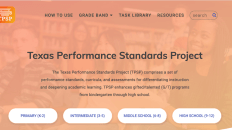Every March I watch round after round of NCAA college basketball. A few inches can make the difference between a game-saving win or a loss. Players practice tirelessly to ensure they’re on target. Much like a few inches can determine a win or loss on the court, aligning our lessons can make a significant impact on student learning. As educators, we need to be just as determined in creating aligned lessons to hit the target of improved learning for all students.
In the Texas Instructional Leadership’s (TIL) Lesson Alignment and Formative Assessment (LAFA) component, teachers learn four steps to align their instruction and assessment practices with the TEKS and to guarantee learning:
- unpacking the TEKS for learning objectives and success criteria
- creating exit tickets
- using weekly assessments
- implementing strategies like aggressive monitoring and show call during student independent practice.
Unpack the TEKS
The first step is to unpack the TEKS. Then identify the critical knowledge and skills necessary for mastering the TEKS’s Student Expectations. Teachers and leaders identify which TEKS are a priority based on student assessment data. Teachers capture the knowledge and skills for the essential TEKS, and then create Daily Learning Objectives and Success Criteria. Breaking down the TEKS contributes to teacher clarity. This has a .75 effect size – almost 2 years of academic growth–in the Visible Learning research. (Learn more about The effect sizes of Dr. Hattie’s metanalyses on influences on achievement at https://www.visiblelearningmetax.com/).
Teachers communicate to students the learning objectives and success criteria in order to “make content clear and accessible to students.”
(Saphier, et al, 2009)
Generate exit tickets
Teachers next generate exit tickets for each lesson connected to the Daily Learning Objective. Exit tickets are created from assessment items like released STAAR questions. Exemplars of ideal student responses give a clear example of what success looks like. They reflect the success criteria students use as a checklist to guide their learning of the learning target.
If teacher clarity has an effect size of .75 in the Visible Learning research, success criteria have an effect size of .88 or almost 3 years of academic growth. Like a good basketball coach having players practice where to stand to be successful in scoring, teachers show students how to line up their learning to a defined target.
Using exit ticket data
After using exit ticket data showing students’ progress toward learning the objective, a teacher creates a weekly assessment. Assessments match the rigor and expectations of the TEKS. This formative assessment allows teachers to plan for the next steps in instruction. Using this data, teachers can answer the question: “How will I know if students have learned what I’ve identified as their learning target?” They can also identify common misunderstandings needing to be retaught and to know what students have mastered. It’s crucial to provide students with feedback on their progress, empowering them to become self-directed learners..
Aggressive monitoring and show call
During student independent practice of the skills needed for mastery, teachers will employ two instructional practices: aggressive monitoring and show call. Both practices come from the work of Paul Bambrick Santoyo and Doug Lemov. They are part of the TIL practices too.
In aggressive monitoring, teachers inform students which specific skill they’ll examine and check during a round of monitoring (called a lap). For example, in an RLA classroom the teacher might announce, “As I check your work, I’ll be looking for your annotated keywords in the text.” This practice allows teachers to collect “in the moment” data on skills students accomplish and which skills need more instruction.
Teachers may also use show call. Show call involves a teacher identifying a student sample demonstrating success and one demonstrating a common misconception. Samples are shared during the practice to allow students the opportunity to see an example and a non-example of the learning goal and to self-correct their own work. Of course, a classroom with show call being used relies upon a teacher-created environment of trust and positive interactions.
Dr. Doug Fisher reminds us, “Every student deserves a great teacher not by chance but by design.”
With the four practices of the TIL Lesson Alignment and Formative Assessment, teachers and leaders know that teaching and learning are on track to guarantee the success of all students. Designing aligned lessons should be every teacher’s first action to achieve this intentional learning for every student.
For more information on the TIL Lesson Alignment and Formative Assessment component, visit our website at https://esc13.net/services/lesson-alignment-and-formative-assessment
Mary Black worked with teachers and principals in creative and strategic planning for curriculum and instruction at schools with diverse student populations. She has years of leadership experience in secondary schools, beginning her educational career as a high school English teacher in an urban high school, also serving as a high school principal.





Add comment